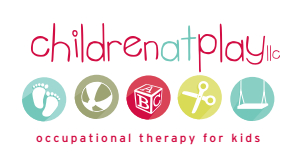Therapy for today’s challenges and long-term sensory integration
At Children at Play, we simultaneously utilize a top-down and a bottom-up approach. A top-down approach helps us meet children and families where they are today and make an impact on their daily lives. A bottom-up approach allows us to use neuroplasticity and sensory integration theory to cause needed nervous system changes. This allows us to help quickly while working towards long-term goals.
Top Down Approach
Meeting your child where they are today- is one of the key components of our therapy. Helping families develop a lifestyle that helps meet the sensory needs of all of their family members is vital in supporting your child’s growth. In therapy, we figure out what works for your child and help you implement those strategies in your daily life. We recommend personalized accommodations such as visual aides, schedules, scheduled downtime, sensory-based activities, activity modifications, sensory suggestions, and others depending on your child's unique needs. We also work on self-regulation coping strategies to help children learn to understand their own nervous system better. Awareness of their body's needs leads to being able to appropriately self-advocate for their needs and preferences.
Using a top-down approach, we help to reduce the child’s overall stress level, giving us better access to their nervous system in therapy sessions and helping accommodate your child’s nervous system today.
Bottom-up Approach
We utilize a variety of occupational therapy frames of reference and combine them in our therapy approach to meet each child’s individual needs. Sensory Integration is one of our major guiding bottom-up theories, which focuses on building the automatic functions that occur in the brain and are responsible for how we respond. Much of the work in the clinic is spent working on the integration of the three primary sensory systems: tactile system (our ability to touch something and comprehend it, including the sense of pain and temperature), vestibular system (located in the inner ear and involved in balance, equilibrium, postural control, muscle tone, and eye-hand coordination) and the proprioceptive system (involved in determining spatial relationships with our body and the world around us).
Using a bottom-up approach, we focus on working on underlying foundational skills that are lacking- in order to promote higher-level cognitive, sensory-motor, and self-regulation skills.
Using Both Approaches
You could loosely think of it as simultaneously addressing symptoms & underlying causes. Top-down aims to improve how the child's challenges are playing out in their school and family life. Bottom Up addresses the underlying causes of their challenges by building the foundational skills and systems they need. Using both approaches allows us to meet your child where they are today to minimize stress responses at home, school, and in the community. While simultaneously making nervous system changes to help your child better take in and organize sensory information in the future.
Pyramid of Learning
The Pyramid of Learning shows how higher-level skills build upon foundational skills.
Our sensory systems create the foundation for higher-level integrated skills. The development of perceptual motor skills and cognition relies on well-integrated sensory systems.
The culmination of the pyramid of learning is often what teachers and parents observe, and we address those challenges with top-down therapy techniques and activities. The sensory system integration is the bottom-up approach and helps us prioritize how to assist a child with therapy to build a solid foundation for continued development and growth.
adapted from Taylor & Trott 1991


